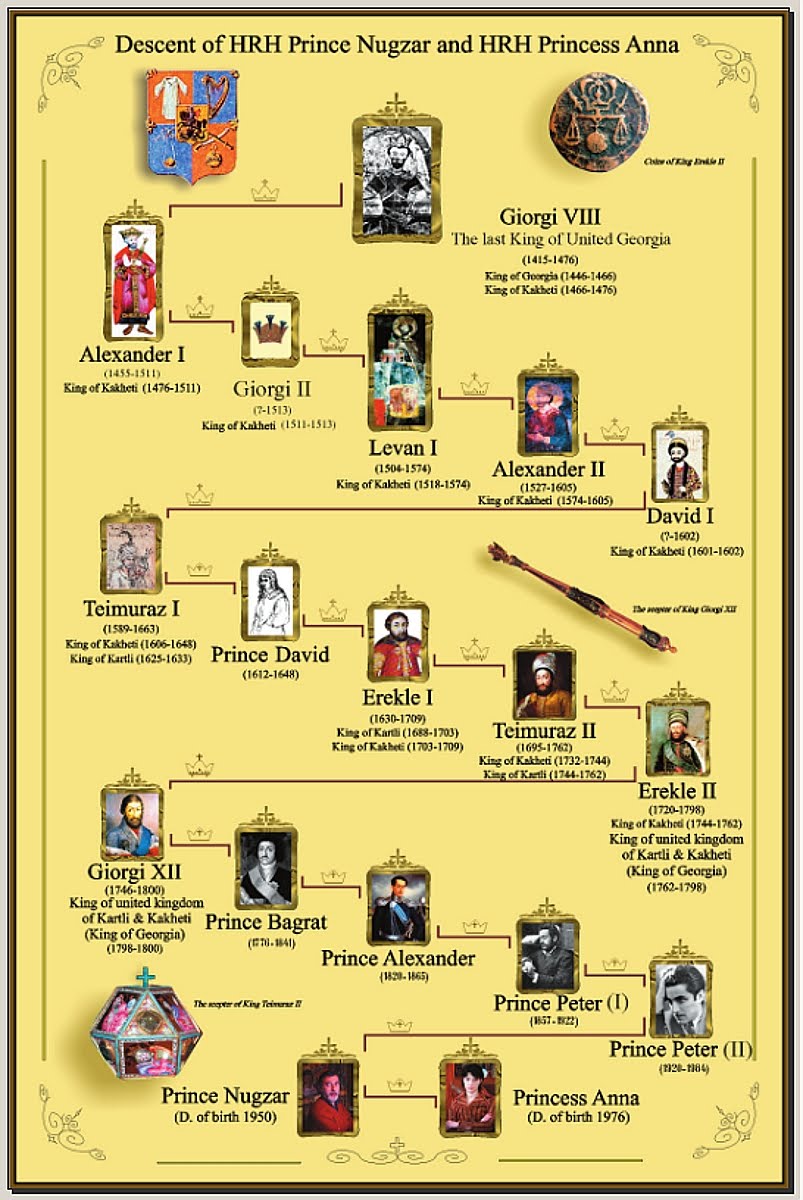The International Commission on Nobility and Royalty | home
A Statement Issued by the Chancellery of the Royal House of Georgia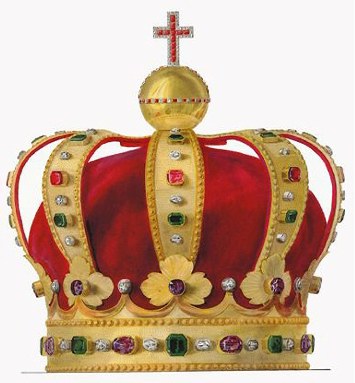

(See Additional Articles below)
The official website of the Royal House:
See also the articles:
Before the statement begins, the following shows the genealogical chart of a number of Royal and Princely Houses of Georgia. However, one needs to go to The Royal Line of Kings & True Successors of the Kingdom of Georgia, and see the new, but briefer chart, because there some important changes that had to be made because modern genealogical research shows that Prince Demetre, Prince David's ancestor, was actually a grandson of Bagrat V (1360-1393) instead of, as formerly thought, to be the eldest son of Alexander I (1412-1442). What this means, is that the royal line of all Georgia (the line of the kings) came exclusively through His Royal Highness Prince Nugzar as the senior line of, not some, but all the kingdoms of the land.
The second reason for this chart is all the valuable genealogy of other lines.
The statement of the Chancellery is below this chart:
Below is the highly detailed chart.
_____________________________________________________________________________________________________________________________________________________________________________________________________________________________________________________________________
********************************************************************************************************************************************************************************************************************************************************************************************************************************************************************************************************
*********************************************************************************************************************************************************************************
_________________________________________________________________________________________________________________________________________________________________________________
The Impact of House Rules on Royal Succession
In the early 1990s, the representatives of several Georgian monarchical organizations met Her Royal Highness Princess Anna, the daughter of the Head of the royal House of Georgia. The representatives, as full-hearted patriots of the cause of monarchy, wanted to remind her about the importance of her origin. She is not a common or ordinary girl, but she is instead a princess of the blood of an ancient royal throne. Therefore, she should dutifully obey the ancient traditions regarding the choice of her future spouse. She took their counsel to heart and adopted the principles as her own. Almost ten years later, the time of her marriage came.
The First Marriage
Princess Anna, like most women of her generation, has the right and inclination to choose her own husband. Her marriage to architect Gregory Malania stemmed from love. Mr. Malania was also a descendent, only through the female line, from the last King of Georgia - His Majesty King Giorgi XII.
The Head of the royal House of Georgia , His Royal Highness the Crown Prince NugzarBagrationi-Gruzinsky, had visited the Patriarch Ilia II of Georgia for advice regarding the marriage of his daughter as a Royal Heir to the throne. The Patriarch listened and told him that love is important. His Holiness the Patriarch also recognizes the importance of tradition and house rules and asked that the princess and the future bridegroom be brought to him so that he could ask that their children carry the royal surname of their mother. This would ensure that the children of the marriage would continue the royal line according to the ancient rules of the House.
The Crown Prince, as agreed, presented the engaged couple to His Holiness the Patriarch. The Patriarch blessed the couple and raised the issue of preserving the royal surname for their future children. Mr. Malania consented to the request and promised to fulfill the agreement. So His Holiness once again blessed the forthcoming wedding.
The Crown Prince of Georgia published news of this wedding agreement and, through his royal prerogative, bestowed upon his future son-in-law the princely title of sakhltukhucesi. Please see the wedding agreement below the picture of the Patriarch for more information.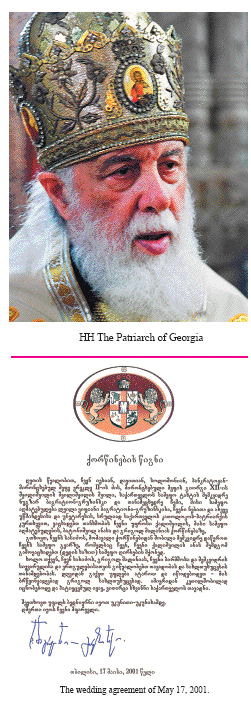
The newly-raised Prince Gregory Malania fully obeyed Georgian dynastic law. This law is based upon a historical “zedsidzeobis” tradition. The ancient law holds that if a husband is not a royal and he marries into a royal family, his surname is not passed to the children so that the royal line of the mother may continue. For more information on this, please see D. Ninidze,The History of the Bagrationi Dynasty Offshoots (XII-XVIIIcc), Tbilisi, 2004, page 41.

Prince Gregory faithfully fulfilled the agreement, and the children born from this marriage carry the royal surname of their mother with the royal pre-nominal titles of "Royal Highness." The Prince consort worked with historians and genealogists and made a considerable contribution in promoting the Royal House. Through his efforts, in 2006, an important historical memorandum was sign by almost all representatives of the Bagrationi dynasty. This memorandum unanimously recognized the superior claim and royal rights of the Bagrationi-Gruzinski family and is in full agreement with international law in regard to clarifying and resolving succession disputes. For information on the law of nations in regard to succession, please see Samuel von Pufendorf, On the Duty of Man and Citizen, Book 2, chapter 10, No. 12, p. 135; Jean J. Burlamaqui, The Principles of Politic Law: being a Sequel to The Principles of Natural Law, Part 2, chapter 3, no. 42(1); and Emerich de Vattel, The Law of Nations, Book 1, chapter 5, no. 66.
While married, Prince Gregory also studied at the Tbilisi Theological Academy. In 2007, as he neared the completion of his studies, problems emerged in the marriage and, regrettably, the couple separated. Despite the separation and ultimate divorce, there remains a positive relationship of respect and admiration between Prince Gregory and His Royal Highness the Crown Prince Nugzar Bagrationi-Gruzinsky.
The Second Marriage
In 2007, His Holiness the Patriarch of Georgia, at one of his weekly sermons, announced that Georgians should discuss different types of political systems. Chief among these is a system of constitutional monarchy, where the King is Head of State but does not rule. This announcement was accepted by most Georgians with gladness.
Within several Georgian monarchical organizations and, unfortunately, even in the backrooms of the Patriarchate, there were people who wanted to use the royal family for their own purposes and when they found that they could not have power and dominion over this family, they would not support them as the true successors.
One reason put forth for the lack of support is that Prince Nugzar has only daughters; therefore, the royal line could not continue in their minds. To this end, various Georgian media artificially tried to represent some male representatives from the different offshoot Bagration branches as the royal candidate. But when proper Georgian and international dynastic laws were brought to the attention of the errant reporters, attempts were made to discredit the rights of Princess Anna and her daughters as eventual heirs to the throne. Some organizations incorrectly declared that if Princess Anna did not marry another Bagrationi line and produce a son from the marriage, the royal line would become perpetually unclear and disputed. Having bypassed the true royal claimant, some organizations deliberately searched for fabricated claimants from the offshoot branches of Kartli, Kakheti, and Imereti. These false claimants would be announced as the rightful claimant in media and then discredited, making monarchy in Georgia appear disorganized and disjointed.
Yet the royal Bagrationi family did not need the second marriage of Princess Anna to ensure a continuation of the royal line, because the succession law clearly designated Her Royal Highness Princess Anna as second-in-line to the throne. After Princess Anna, Her Royal Highness Princess Irine Bagrationi-Gruzinski, the eldest daughter of Princess Anna, is the next rightful claimant.
Prior to the second wedding, Princess Anna was 32 years old, and a second marriage could lead to additional royal children resulting from the marriage. Therefore His Royal Highness Crown Prince Nugzar consented to the idea of a second marriage for his daughter. Yet legally, within the constraints of Georgian royal tradition and House law, the royal family had no dynastic need for this second marriage. But His Royal Highness Prince Nugzar consented to the Patriarch's wish for union between these families. It was believed that union would resolve all discord resulting from the Mukhranski family unlawfully usurping the royal rights and prerogatives of the Bagrationi-Gruzinski family while in Spain in the 1940s and continuing to the present. For more information, please see V. Kiknadze, The Heir Family of the Georgian Throne, Tbilisi, 2006. Given that the Mukhranski claim, although incorrect, had gained momentum in some circles, it was believed that this union of marriage between the rightful Bragrationi-Gruzinski line and the Bagration-Mukhranski line would stop all the hostile forces against monarchy in Georgia. Furthermore, it was believed that the union could wash away the troubled history and animosity between the two families. This is why the Crown Prince consented to the idea of union sponsored by the Patriarch of Georgia.
Since a relationship of love seemed to be developing between Prince David and Her Royal Highness Princess Anna, it seemed appropriate to proceed. However, Princess Anna's first husband refused to permit a divorce for a time, but out of a sincere respect for the Patriarch and the Royal House of Georgia, he eventually agreed to a formal divorce.
In 2008, when the Patriarch of Georgia arrived back from the funeral of the Russian Patriarch Aleksy II, His Holiness met with the Head of the royal House of Georgia, Prince Nugzar, and the future son-in-law Prince David. Discussion centered upon a wedding date of Easter in April of 2009. Additionally, with Prince David present, His Royal Highness Crown Prince Nugzar insisted upon a wedding contract. The wedding contract was to be akin to the first marriage of Princess Anna, and the purpose of the contract was to follow dynastic house rules to preserve the royal rights and dynastic priority of Princess Anna and any future children of the marriage.
The document would further define the legal title and status of both spouses, thereby preserving the royal inheritance from the mother for any future children. This would allow the children to be formally of the royal line and entitled to a place in succession. Thus, Prince David would become Prince consort for Her Royal Highness Princess Anna of Georgia, similar to the status once held by Princess Anna's first husband. This would allow David to be the father of a future heir to the throne, which is a great privilege in its own right. While Prince David would be head of the home, he would not be the de jure Head of State or the Head of the Bagrationi dynasty. That would be Princess Anna's exclusive right given that Prince Nugzar has designated her as his heir. Without this contract, Georgian dynastic law and traditions would be violated, and any children born from the union would not be royal and entitled to succeed as potential heads of the dynasty. Instead, the children would simply be high nobles of the Bagration-Mukhranski line and not royal.
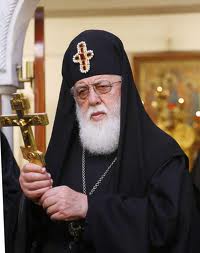 The Patriarch concurred and thought that there would be plenty of time before Easter for both parties to prepare the necessary documentation to enact the contract. As part of this agreement, His Royal Highness Prince Nugzar, in good faith, transferred all important historical and genealogical documents to the Patriarch.
The Patriarch concurred and thought that there would be plenty of time before Easter for both parties to prepare the necessary documentation to enact the contract. As part of this agreement, His Royal Highness Prince Nugzar, in good faith, transferred all important historical and genealogical documents to the Patriarch.
Per Georgian tradition, prior to the wedding, Prince David visited the head of the royal House, Prince Nugzar, to officially ask the hand of his daughter. While visiting the Crown Prince's home, David apologized on behalf of his Bagration-Mukhranski ancestors for incorrectly trying to usurp the rightful Bagrationi-Gruzinski royals for roughly 70 years. He further stated that the Bagration-Mukhranski attempted usurpation stemmed from a belief that all Bagrationi-Gruzinski line members had not survived Russian occupation. Prince David confirmed verbally that the Bagrationi-Gruzinski family had the highest entitlement to the Crown of Georgia.
While the wedding was originally set for Easter of 2009, due to intense political problems within the country, the Patriarch unexpectedly asked His Royal Highness Crown Prince Nugzar and Prince David to set the wedding date much sooner. His Holiness the Patriarch proposed the date of the 8th of February, and premarital preparation began by the Patriarchate. But in late January of 2009, the Patriarch suddenly got sick and had to leave for Germany to receive special treatment. Unfortunately, because of time pressures and the already announced wedding date of the 8th of February, there was not enough time for the creation of the wedding contract. The Patriarchate had already sent out wedding invitations to several royal houses; therefore, prolongation of the wedding date became impossible. Because of the non-participation of the Patriarch himself at the wedding ceremony given his medical needs, the dynastic law requirement was not completed. The Head of the royal House, Prince Nugzar, during his official speech at the wedding, emphasized the transcendent rights of his daughter. The speech was accepted by the audience as a verbal decree and confirmation of his rightful heir to the throne, but this did not resolve the problem of a violation of dynastic law in regard to the children of the marriage.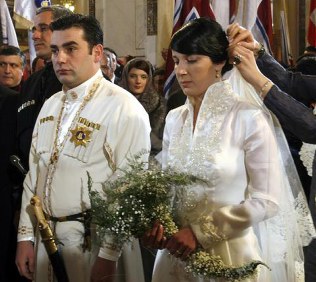
Barely over a month after this wedding, relations between the spouses deteriorated because of unworthy behavior of Prince David. Furthermore, Prince David also proclaimed on his internet site that he was the head of the royal House of Georgia, thereby again usurping the legal rights of the true heir to the throne. Given David's behavior, Princess Anna had to return to her father's home.
The situation was strained. Time passed and the Georgian public was left in the dark. To reduce public pressure, some Georgian officials urged Prince Nugzar to establish a Chancellery for the royal House. The Chancellery was designed to protect royal claims as well as develop, enhance, and stabilize the situation.
On the 7th of November of 2009, the Crown Prince published a special decree. Within the decree, he expressed gratitude to his supporters for their merit and allegiance while simultaneously establishing the Chancellery. The Chancellery obtained all necessary documentary materials concerning the succession to the throne of Georgia. It also proved the supreme priority of Prince Nugzar as head of the Bagrationi dynasty in accordance with international and Georgian dynastic laws.
On the15th of December 2009, the royal Chancellery of His Royal Highness Prince Nugzar sent an official letter with attached material, 62 pages in all, where all the nuances of the situation were analyzed. The letter also asked to meet with the Patriarch in order to find the best solution.
During the visit with His Holiness the Patriarch, it was decided that representatives of both parties complete the wedding contract as agreed to prior to the wedding in accordance with the ancient house rules. In all, four meetings were held between the two parties. The agreement would formally recognize and confirm Prince Nugzar as the head of the royal Bagrationi house. By virtue of marriage to his daughter, Prince David would be granted full royal rights, including the pre-nominal title of “His Royal Highness,” as Prince consort of Princess Anna. The chivalric Orders invented by David's ancestors that lacked a true fons honorum would be legitimized under Prince Nugzar. Prince David would be allowed to retain the income these Orders provide, and they would be officially part of the Bagrationi honors system under His Royal Highness Crown Prince Nugzar. Most importantly, children of the marriage would be recognized as royal with succession rights.
Despite the fact that Prince David, at the beginning of the discussions, was ready to sign the contract, he unexpectedly did not sign the binding agreement. Instead, he left for Spain. Copies of these agreements, including royal protocols, are held by the royal House Chancellery, the Patriarchate, and Prince David.
The following is a scan of the dynastic contract:
______________________________________________________________________________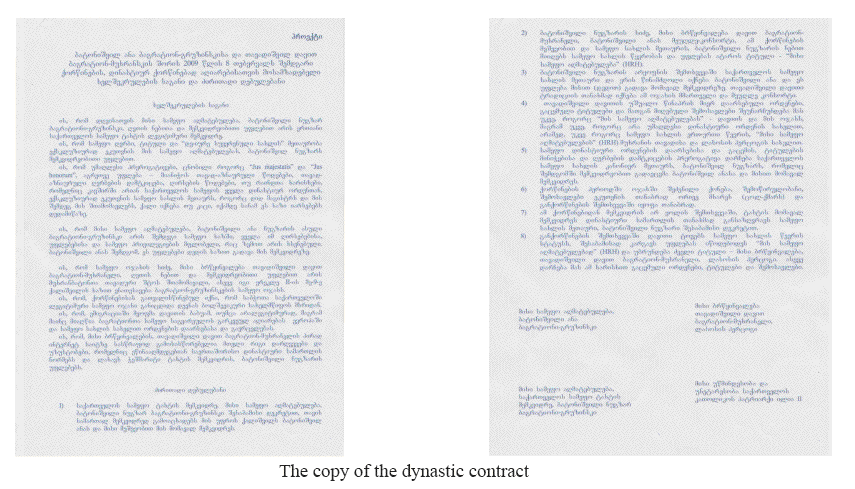
______________________________________________________________________________
In the eyes of the Georgian public, Prince David's behavior has been interpreted as illogical and raised suspicion. By his actions, he has refused to be the prince consort of his wife and thereby kept children of the marriage from a place in line to the de jure Georgian throne.
But there may be some compelling information that offers a reasonable explanation. The Georgian internal affairs minister, Mr. Vano Merabishvili, revealed something heretofore unknown. He speculated that the wedding to Prince David was a project sought by Russian ex-Prime Minister Yevgeny Primakov. Please see the Georgian newspaper - "Siakhle", dated the 14th of April, 2010. Therefore, the royal Chancellery began an investigation and started collecting information in the hope of shedding light on Prince David's sudden and unexpected withdrawal from discussions.
A representative of the Russian nobility, Prince Sergei Dadiani stated:
Here in Russia with the support of David are engaged the "legitimists," which are supporting Maria Romanova and propose to hide her morganatic origin (the marriage of her father Grand Duke Vladimir Kirillovich to Princess Leonida Bagration-Mukhranski) such that it is profitable for them to present prince David as heir to the throne of Georgia.
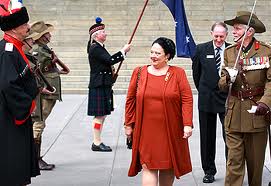 Information obtained by the royal Chancellery concludes that Prince David's behavior may be related to David's grandfather's sister, Leonida Bagration-Mukhranski. Her marriage to Vladimir Kirilovich Romanov produced Maria Vladimirovna, who is a claimant to the Russian Imperial Throne. These persons try to circumvent the morganatic requirements of Russia by portraying the Mukhranski branch as belonging to the Kartli royals. The information on which these claims are made is flawed and is recognized as such by the majority of the Romanov family.
Information obtained by the royal Chancellery concludes that Prince David's behavior may be related to David's grandfather's sister, Leonida Bagration-Mukhranski. Her marriage to Vladimir Kirilovich Romanov produced Maria Vladimirovna, who is a claimant to the Russian Imperial Throne. These persons try to circumvent the morganatic requirements of Russia by portraying the Mukhranski branch as belonging to the Kartli royals. The information on which these claims are made is flawed and is recognized as such by the majority of the Romanov family.
From the previously mentioned book of V. Kiknadze, one can easily discern that Prince Irakli Bagration-Mukhranski, David's grandfather clearly knew about his origins. Prince Irakli presented himself on the so-called "Berlin elections" of 1942 as a descendant of Princess Ketevan, the ninth daughter of King Erekle II. The other candidate in the so-called “Berlin elections” of 1942, Prince Simon Tsitsishvili, was descended from the fifth daughter of the King, Princess Mariam. Thus, the two Princes had roughly the same succession position in the Bagrationi dynasty, which was far removed from Prince Nugzar's line. Prince Nugzar's line was presumed not to have survived the Russian occupation.
This was the only argument Prince Irakli presented at the elections in claim of the royal throne. If he had a much stronger position as now claimed by his grandson Prince David, why did he not submit it in 1942? In contrast, the genealogical table submitted in the 1942 so-called elections did not show any heir coming from King George XII, which was the line Prince Nugzar comes from, as it was presumed to be extinct. It is from this error that the basis for the Mukhranski claims has derived. For more information, please see V. Kiknadze, The Heir Family of the Georgian Throne, Tbilisi, 2006.
In an effort to be a legitimate dynast of the Romanov House, Mrs. Maria Vladimirovua attempts to portray her mother's non-royal origin (Mukhranski) as a royal bloodline. Because of the morganatic, or unequal marriage, requirements of Imperial Russia, Ms. Vladimirovua's Mukhranski mother disqualified her line from succession. For more information, please see M. Nazarov's web article (in Russian) at:
These websites raise a large number of serious accusations against the Mukhranski family. One would think that the family would protest any untruths and attempt to correct any errors, but there has been no attempt to mitigate these concerns.
 There are also widely publicized myths that in the early 1990s, the Georgian government and His Holiness the Patriarch recognized George (Jorge) Bagration-Mukhranski as the heir to the Georgian throne. No such evidence of this exists at all, especially in written form. However, there is an interesting written letter by Maria Bagration, Prince David's aunt, which indicates that her father excluded Giorgi (David's father) and his descendants from their rights. If true, then David, and his siblings, would not even be princes of the nobility of Georgia, let alone royal claimants.
There are also widely publicized myths that in the early 1990s, the Georgian government and His Holiness the Patriarch recognized George (Jorge) Bagration-Mukhranski as the heir to the Georgian throne. No such evidence of this exists at all, especially in written form. However, there is an interesting written letter by Maria Bagration, Prince David's aunt, which indicates that her father excluded Giorgi (David's father) and his descendants from their rights. If true, then David, and his siblings, would not even be princes of the nobility of Georgia, let alone royal claimants.
Under Georgian dynastic law, Prince Nugzar from birth was a lawful successor to the Georgian throne. Upon the death of his father, Crown Prince Peter II in 1984, Prince Nugzar became Head of the royal House of Georgia. He owns all the rights, privileges, and prerogatives of his royal status; however, he never requested or demanded privileges. He does not flaunt his royal station.
Therefore, during Easter of 2010, by the order of His Royal Highness the Crown Prince and Princess Anna, the royal Chancellery issued the following statement. It was published in the Georgian journals and newspapers. A link to the statement may be found here:
http://georgianroyalhouse.jimdo.com/history-and-genealogical-tables
This statement quickly spread around the world, and it has significantly changed the world community's representations about the royal House of Georgia. Previously established misconceptions are giving way to truth about the royal House.
A force of stability, the Patriarch of Georgia urged Princess Anna to reconcile with her husband with the hope of preserving the family. In October of 2010, when His Holiness returned from his medical treatment from Germany, he requested that Princess Anna leave immediately for Spain to give her husband another chance. The Patriarch declared that David should not have left the country without the consent of His Holiness. Trusting the Patriarch and her own feelings, Princess Anna left for Spain in an attempt to try to reconcile with Prince David. While leaving, she promised that she would never go against the legitimacy of the true royal House.
Princess Anna left for Spain on the 12th of November in 2010 and entered into a Spanish civil marriage with her husband. Further, she gave birth to a son, Giorgi, on the 27th of September in 2011. Unfortunately, the aforementioned royal succession marriage contract was not signed by Prince David prior to their son's birth. Therefore, under international and Georgian dynastic law, Prince Giorgi is not a royal. He is instead a prince of the Bagration-Mukhranski nobility line. He is not a dynast of Georgia and has no succession rights.
For evidence of this, one need only look at Georgian history. The King's daughters often married Georgian nobility, such as the Princes Eristavi, Tsitsishvili, Orbeliani, Mukhranbatoni, etc. Children born from these marriages inherited the surnames of their fathers and were not members of the royal House.
Georgian dynastic law, called Zedsidzeoba, has prevailed in Georgia for hundreds of years. When there was only a female dynast, upon her marriage, a husband would lose his own surname (gvartomoba) and thus children of the marriage would carry the royal surname of the mother and consequently inherit succession rights in the royal House. For example, when the female King of Kings (albeit really Queen of Queens) Rusudan I of Georgia married Moughir-ed-Din, Emir/Sultan of Erzerum, the son born from this marriage carried the mother's surname. He later became King of Georgia as David VI Bagrationi, who ruled from 1245-1259. It should also be noted that the consort-husband of King (really Queen) Rusudan belonged to a sovereign house, and so they had equal status. Nevertheless, Georgian dynastic law was preserved and her name was given to the children.
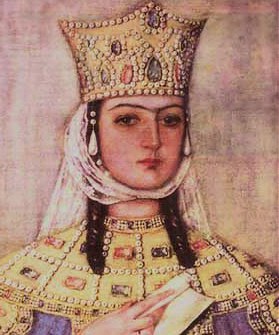 Another historical example is King of Kings (really Queen of Queens) Tamar of Georgia. She married Prince David Soslan, who was a member of the Bagrationi Dynasty that ruled Alania (modern-day Ossetia). While both King (Queen) Tamar and the Prince consort had identical surnames, the son born from this marriage in historic sources is known as King Giorgi IV Bagrationi. King Giorgi IV reigned from 1210 - 1223. Historical sources demonstrate that King Giorgi IV in accordance with succession rules inherited his royal rights through his mother, not his father.
Another historical example is King of Kings (really Queen of Queens) Tamar of Georgia. She married Prince David Soslan, who was a member of the Bagrationi Dynasty that ruled Alania (modern-day Ossetia). While both King (Queen) Tamar and the Prince consort had identical surnames, the son born from this marriage in historic sources is known as King Giorgi IV Bagrationi. King Giorgi IV reigned from 1210 - 1223. Historical sources demonstrate that King Giorgi IV in accordance with succession rules inherited his royal rights through his mother, not his father.
The examples mentioned above clearly demonstrate how Georgian dynastic law impacts marriages. These laws are ancient, and there is not a mechanism to change them. This is why Prince Nugzar requested that the marriage contract be prepared and signed to fulfill the ancient requirements just like he did in the first marriage of HRH Princess Anna.
Because the legally binding marriage contract was not signed, dynastic law was not met by Prince David. Consequently, according to Georgian dynastic law, any children born from this marriage, including Prince Giorgi, will not be royals or dynasts. Instead, they will be members of the Bagration-Mukhranski princely line. This cannot change unless Prince David agrees to sign and honor the marriage agreement and Georgian dynastic law. It is important to note that a male descendent of the Royal House has priority over any females in the line of succession. Were Prince Giorgi to become a dynast, he would be the heir apparent to the throne after his mother.
If the House Rules are followed, the controversy between these two branches could be forgotten and the royal prerogatives and sovereign rights could be shared through the posterity of Prince David and Her Royal Highness Princess Anna. Only Prince Nugzar, as Head of the royal sovereign House of Georgia, could initiate a change in the succession. According to international law, such a change would require a majority decision of all true dynasts that hold genuine succession rights. Ancillary Georgian princely lines, including the Bagration-Mukhranski family, could not participate as they do not hold dynastic rights. For additional information, please see Samuel von Pufendorf, On the Duty of Man and Citizen, Book 2, chapter 10, No. 12, p. 135; Jean J. Burlamaqui, The Principles of Politic Law: being a Sequel to The Principles of Natural Law, Part 2, chapter 3, no. 42(1); and Emerich de Vattel, The Law of Nations, Book 1, chapter 5, no. 66.
The Chancellery of His Royal Highness Crown Prince Nugzar appeals to everyone to respect the binding rules of the de jure Kingdom of Georgia. This includes preserving the legitimate and rightful claims to the throne of this ancient and beautiful land under dynastic law.
It is hoped that His Royal Highness Crown Prince Nugzar's grandson, Prince Giorgi, may yet obtain a place in the royal line. While Prince David so far has chosen to ignore and breach these ancient traditions, the royal House would welcome Prince David fulfilling his earlier obligations. Such action would serve to unite his family line with the royal line, and he could be the father to a future heir of the throne.
We pray God's blessings on all and for the future of the Georgian people.
 The origin of the princely family of Bagration-Mukhrani and their legal and social status in the XVI-XX centuries.
The origin of the princely family of Bagration-Mukhrani and their legal and social status in the XVI-XX centuries.
Samukhranbatono - name of princely fief where the owners of this territory since its inception in 1512 were the representatives of an offshoot princely line of Bagrations. Needs to be underlined that this particular princely line emerged only after the united Georgian Kingdom was split into three small kingdoms thus this line was an off- shoot from Kartli royal house rather than from the Royal House of Georgia and moreover, the first sovereign of the kingdom of Kartli and the founder of this separate territorial entity was not a member of the Royal House of United Georgia but just a distant relative.
Mukhrani - is a historical lowland district in eastern Georgia. It lies within the historical borders of Kartli, bounded by the Kura (Mtkvari) River, and its two tributary streams: Ksani and Aragvi.
Mukhranbatoni - Senior owner (Prince) of the territory (princely fief) of Mukhrani.
In 1512 with the emergence of new “Satavado” (Princely fief without individual sovereignty) “Samukhranbatono”, was led by the Princely Family of Mukhranbatoni and Bagration-Mukhranski. This princely offshoot has emerged from the royal house of Kartli of the Bagrationi Dynasty. They were high nobles and managers of this particular fief. The right to be the prince of Mukhran-Batoni was not always hereditary, but depended on whom the king chose out of this noble house to preside. The first Prince of Mukhranbatoni was the third son of the King of Kartli Constantine II - Prince Bagrat (? -1540). The reason for the formation of this “Satavado” and thereby the princely Line of Mukhrani consisted in the politics of the time. King David X divided Kartli Kingdom in 4 Military-Administrative Regions “Sadrosho” (territorial unit) (Military Districts), one of which was leaded by Bagrat Mukhranbatoni. Besides “Satavado Samukhran- batono”, this Military District also included the territories of the two other non-sovereign princedoms - Ksani and Aragvi “Saeristavo” or Princely fiefs. As said, these “Satavado" did not have their own sovereignty or any indepen- dent right to rule. They were completely subject to the Rulers and Kings of Kartli and later Kings of Kartli-Kakheti.
Thus arose one of the first Princely Branches from the Royal House of Kartli. The status of this princely branch was briefly expressed by Prince Ioane of Georgia, when he states: “[They are] second degree Bagrationi and first degree princes”. (Prince Ioane of Georgia, a brief description of the nobility of Georgia, n.p. “Iveria” V-VI, 1884; Brief description of living of the Princely and Noble Families in Georgia. The editor and publisher O.Katselashvili, Tb. 1997, page 29).
Only the Head of the Mukhranski Princely House - Prince Mukhranbatoni was the 1st Degree Prince, but all his younger relatives – Mukhranbatonishvili (literally - "children of Mukhranbatoni") were the Princes of the 2nd and 3rd Degrees. Since their origin in 1512 and up to the 20th century, the representatives of Mukhranbatoni and Bagration-Mukhranski retained their non-sovereign princely status. This is evidenced by numerous certificates issued by the Georgian Kings, historical sources and archival materials that are listed in chronological order.
One of the earliest historical sources, in which is mentioned a legal status of Princes of Mukhranbatoni, is a "Paris Chronicle", which indicates the event occurred in 1609: "Mtkvari was a full-flowing at that time. It was June. Prince of Mukhrani, Eristavs (means the princes of Aragvi and Ksani), Amilakhvari were on the other side”. (Paris Chronicle. Translation, study notes and pointers G.G.Alasania. Tb., 1991, page 45).
In the same historical source, there is an evidence of much earlier representatives of this Princely house, "In 1555 Shah Tamaz came in Kartli the second time. The sons of the owner of Mukhrani: Archil, Ashotan and Vakhtang arrived to Atskuri." (Paris Chronicle. Translation, studies, notes and pointers were fulfilled by G.G.Ala- sania. Tb., 1991, p.30) and "On 1578 the owner of Mukhrani, Vakhtang, the son of the owner of Mukhrani Bagrat, when entering into the Temple was captured by the lord King Simon and imprisoned into the Kekhvi Castle." (Paris Chronicle. Translation, studies, notes and pointers made by G.G.Alasania. Tb., 1991, page 36).
Another historical source is the "History of Georgia" written in the 17th century by Parsadan Gorgidzhanidze, which relates to events that occurred between 1625 and 1635, Representatives of the Mukhranbatoni princely house along with other Princely houses of Kartli Kingdom: ". . . Eristavi (Prince) Iase of Ksani and owner of Mukhrani (Prince of Mukhrani) - Teimuraz . . .", and "[the King] Teimuraz was joined by Kakhetians, both Eristavs, Mukhranbatoni, Iotam Amilakhvari ...“ (Parsadan Gorgidzhanidze. History of Georgia. Translated by R.K.Kiknadze and V.S.Puturidze. Research and pointers fulfilled by R.K.Kiknadze. Tb., 1990, page 81,92).
In this same historical source, we find, that King Teimuraz I after the Battle at Bazaleti, which took place in 1626, abolished the “Satavado Samukhranbatono”, and its lands and ownership which he granted to his son, HRH Prince David, that is: "King Teimuraz (I) gave Mukhrani to his son Datuna ... " (Parsadan Gorgidzhanidze. The History of Georgia. Translated by R.K.Kiknadze and V.S.Puturidze. Research and pointers fulfilled by R.K.Kiknadze. Tb., 1990, page 92).
In 1716, Vakhtang VI once again to became the King of Kartli and his son, Prince Bakar as his deputy became, “Dzhanishin” (Ruler) of Kartli. King Vakhtang VI demanded that HRH Prince Bakar punish the supporters of his younger brother, the former King Iese. In 1717, “Dzhanishin” of Kartli – Prince Bakar ordered to seize prince Erekle Mukhranbatoni, blind him and then to appoint the son of the former Mukhranbatoni Papuna - prince Levan, as the new Mukhranbatoni. In the historical source concerning this event: ". . . The Shah called upon Vakhtang, [and] gave [him] Kartli and the title of sipahsalar (Persian) of Iran . . . and as the governor of Kartli was as- signed his son Bakar. Bakar . . . ordered by his father [King Vakhtang VI] grabbed Erekle Mukhranbatoni and blinded [him], and then gave Mukhrani to the son of Papuna - Levan". (Vakhushti Bagrationi. The History of Georgian Kingdom. Translated, supplied with the foreword, dictionaries and indexes by N.T.Nakashidze. Tb., 1976, page 104).
According to the document issued in 1720, the King of Kartli (Vakhtang VI) has divided the land of this princely fief (“satavado Samukhranbatono”) between the representatives of this Princely Family (see: Monuments of Georgian Law. Tome VI. Published by I.Dolidze, Tb., 1977, str.689-693 (in Georgian language) and in 1721 King Vakhtang appointed his younger brother - Prince Iese as a new Mukhranbatoni (Monuments of Georgian Law. Tome IV. Published by I.Dolidze, Tb., 1972, page 395 (in Georgian language).
The following historical document also clearly evidences that Prince Mukhranbatoni was part of the Nobility of the Kartli Kingdom. In 1724, the King of Kartli Vakhtang VI with family was forced to leave Georgia and moved to Russia. Together with the King, his numerous retinue also left the country. After listing the members of the royal house then begins listing of the King's entourage. As part of this retinue there were the chiefs of “Sadrosho” (military districts), and among them was listed - the full General of troops of the right flank - Prince Vakhtang Amilakhvari (patronymic of Avtandil) as well as the full General of the left flank, Prince Levan Mukhranbatoni (patronymic of Papuna). The documented information regarding the composition of those who left with the King of Kartli (Vakhtang VI), are given in the Book of the Historian S.Kubaneyshvili as follows: "The List of retinue of King Vakhtang VI dated 1724. List A: Georgian King Vakhtang (patronymic of Levan), princes, nobles, and his servants. The full Generals of the left, right and front flanks of the troops of the Georgian King: the full General of troops of the right flank of Upper Kartli, Prince Vakhtang Amilakhvari (patronymic of Avtandil). The full General of the left flank, Prince Levan Mukhranbatoni (patronymic of Papuna)". (List of the retinue of King Vakhtang VI dated 1724. List A. S.Kubaneyshvili. David Guramishvili in Regiment of Georgian Hussars. Tb., 1965, pages 121-22 (in Georgian language)
In 1778, King Irakli II granted a monetary gift to his son-in-law, the Prince Ioane Bagration-Mukhranski (patronymic of Constantine). (D. Ninidze. Samukhranbatono. Tb., 1997, p.56 (in Georgian. Lang.).
The social status of the Princes Mukhranbatoni is also shown in the Interstate Document known as “The Treaty of Georgievsk,” concluded in 1783 between the Russian Empire and King Irakli II. This document indicated that King Irakli II authorized his Ambassadors and faithful servants - Prince Ioane Mukhranbatoni and Prince Garse- van Chavchavadze to sign the above-mentioned document:
. . . Chosen and authorized faithful and loyal servants to us - Prince Ioane Bagrationi (patronymic of Kon- stantine), the full General of troops of the left flank and also the Chief Adviser in matters of Erevan province, Prince Garsevan Chavchavadze (patronymic of Revaz), of our Adjutant General and Overseer of the Kazah province, by which we give a full power of attorney ... (Treaty of Georgievsk. The Contract concluded on 1783 “Concerning the accession of Eastern Georgia under Russian auspice”. The text was prepared for publication, intro- duction and notes were supplied by G. G. Paychadze. Tb., 1983, page 68).
In the nobility List of Georgia that was signed and presented by King Irakli II and attached to the Interstate “Treaty of Georgievsk” of 1783, Prince Mukhranbatoni is listed among the other non-sovereign Princes of Kartli. This was stated in the Document: "List of the Princes and Nobles of Kartli-Kakheti. List of the Kartlian Princes. Prince Mukhranbatoni Bagrationi" (Treaty of Georgievsk. Agreement of 1783 concerning the accession of Eastern Georgia under Russian protectorate”. The text was prepared for publication, introduction and notes were supplied by G. G. Paychadze Tb., 1983, p.57 (in Georgian language).
Till present day there has survived the gravestone of the above mentioned Prince Ioane Mukhranbatoni, located in the Cathedral Church Svetitskhoveli on which is placed the Epitaph of 1800. It clearly evidences the status of his descendants:
Offspring of the Bagrationi family, son of Mukhranbatoni, Sardar Sakhltukhutsesi (Minister of Economy of the Royal Court) Constantine, Mukhranbatoni, Sardar Sakhltukhutsesi and Governor of Erevan . . . left his beloved [monogamian] wife, daughter of Irakli II, the King of all Georgia, Ketevan, in sorrow for ever. . . . (A.Natroev. Mtskheta and its Cathedral Church Svetitskhoveli. Tiflis, 1900, page 331).
In 1800, King Giorgi XII issued a Letter of granting the title of Mukhranbatoni to Prince Constantine (patro- nymic of Ivan) Bagration-Mukhranski. In this document is stated, that the King... "... has bestowed the title of Mukhranbatoni and approved onto this title Constantine, son of Ioane...." (Platon Ioseliani. Life of Giorgi Thirteenth. Tb., 1978, page 151 (in Georgian language).
After the abolition of Georgian Kingdom, Russian Government issued a List of the Members of the Royal House of Georgia. The mentioned list, besides of listing the royal persons, also indicates the names of their spouses, so along with other sons-in-law of the Royal Family also mentioned Prince Ioane Mukhranbatoni as a spouse of the royal Princess Ketevan (the 9th daughter of King Erekle II). (The Family Tree of the Persons of Georgian Royal Family during the accession of Georgia into Russia. The Archives of the Ministry of Internal Affairs, the Letter ? 735 of Knoring to Obolyanov dated on April 1, 1801. In the book: N.Dubrovin Transcaucasia since 1803 up to 1806. Saint Petersburg, 1866).
The same is indicated in the Acts of Caucasian Archaeological Commission published in 1866, which also shows a list of the members of the Royal House of Georgia, where Prince Ioane Mukhranbatoni is mentioned only as son in law of the royal family same as Princes Tsitsishvili and Tarkhan-Mouravi for example. (see: Georgian Royal House. 161. List of the Georgian Royal Family. Acts collected by the Caucasian Archaeological Commission, tome I, Tiflis, 1866 pages 199-200). (See Document ?16)
October 30, 1820, Prince Constantine Bagration-Mukhranski (patronymic of Ioane) applied with a request to the Tiflis Assembly of Noble Deputies concerning his approval in the princely dignity. This petition reads as follows:
As evidence of an ancient origin of my princely family, herewith I am presenting the Documents that were issued to the ancestors of mine, as well as to my late father - Prince Ioane Mukhranski by the Georgian Kings.: 1st. from [king] Giorgi in 1687; 2nd. [king] Erekle in 1784 and the 3rd from [king] Giorgi in 1798, as equally the pedigree with the family list, and by evidence of 12 Noble persons in regards to our origin from that of surname, that is shown in the Treaty of Georgievsk concluded by the Russian Imperial Court with the late King Erekle in 1783. I humbly beg you to include our family name into the Nobility Lineage Book and to provide me with diploma that evidenced from the extract of family lineage along with brothers [In Georgian: Major-General Constantine Mukhranbatoni (Signature)]. (Case of Tiflis Assembly of Noble Deputies regarding the petition by Major General K. I. Bagration-Mukhranski for his approval in the Princely Dignity. Central Histori- cal Archive of Georgia (CHGA), ?213 Fund, Series 1, Case ?63 (October 30, 1820 - June 24, 1915), sheet 1).
In this same archival document, the Prince Constantine Bagration-Mukhranski (patronymic of Ioane) presents his genealogical table, which begins with his direct ancestor, Prince Teimuraz Mukhranbatoni and comes down to his sons (CHGA, Fund 213, Series 1, Case 63, sheet 9-10).
This archival file also kept another petition addressed to the Tiflis Assembly of Noble Deputies, dated 1915, which belongs to the Marshal of Dusheti District Nobility Prince Giorgi Bagration-Mukhranski (patronymic of Alexander) on inclusion of his children Irakli, Mary and Leonida into the princely family of Bagration-Mukhranski and issued him the birth certificates for his children (It should be emphasized that Irakli which is listed among children of the above-mentioned prince Giorgi was the grandfather of prince David Bagration-Mukhranski, whose baseless and ungrounded claims to the Georgian throne are still ongoing.) (CHGA, Fund 213, Series 1, Case ?63, sheets 294, 299, 300, 301).
On November 24, 1820 the representative of another branch of this Princely house, Prince Giorgi Bagration-Mukhranski (patronymic of Simon) petitioned to the Tiflis Assembly of Noble Deputies on his approval in the princely dignity. In confirmation of his princely origin, he provided a Letter of King of Kartli Simon II. In the above-mentioned petition it stated:
Petition of the landowner from the Ananuri district, captain and cavalier Prince Giorgi Bagration-Mukhranski son of Simon to the Georgian Assembly of Noble Deputies: In evidence of our princely origin I submit to you herewith a Letter issued by the King Simon in 1618 that was granted to our ancestors; equal to the evidence of 12 Noble persons concerning that our Princely family name is shown in the Treaty concluded by Russian Imperial Court with the deceased King Erekle in 1783, and the pedigree with the family list, humbly begging an honored Assembly to include our family name into the Nobility Lineage Book and to issue a Certificate. [Signed in Georgian: Captain Prince Giorgi Bagration]. November 24, 1820. (Case of Tiflis Assembly of Noble Deputies for petition of the Captain Prince G. S. Bagration-Mukhranski with regard to recognize his family line into the Princely Dignity. The Central Historical Archive of Georgia (CHGA), Fund ?213, Series 1, Case ?117 (November 24, 1820 - March 30, 1915), sheet 1).
In 1892, in the official edition published by the Department of Heraldry of the Governing Senate of Russian Empire, Princes of Bagration-Mukhranski are presented among the titled nobility, not royalty. When in the same edition the descendants of the former Royal House of Georgia are mentioned as Serene Highness Princes /Princesses of Georgia. (The Princes of Bagration-Mukhranski. Lists of titled families and personalities of Russian Empire. The publication of the Department of Heraldry of the Governing Senate. Saint Petersburg, 1892, page 12).
Articles in this section include:
We encourage you to read and enjoy the articles that follow, which are informative and can deepen one's understanding of the whys and wherefores as well as the true and permanent rights of royalty, nobility and chivalry. The following articles are considered to be especially important and valuable:
Use "Contact" to join the Commission as a contributor or apply for certification for titles, knighthood, status or ancestry. Our goals and mission are to protect the public from counterfeit titles, phony knighthoods and fake genealogies. We certify the true and the genuine as well as promote chivalry, royalty and nobility. There is so much that needs to be done. We invite you to contribute and join with us.
Contact or donate through the following:
© Copyright 2005/2009 -- International Commission on Nobility and Royalty. All Rights Reserved.
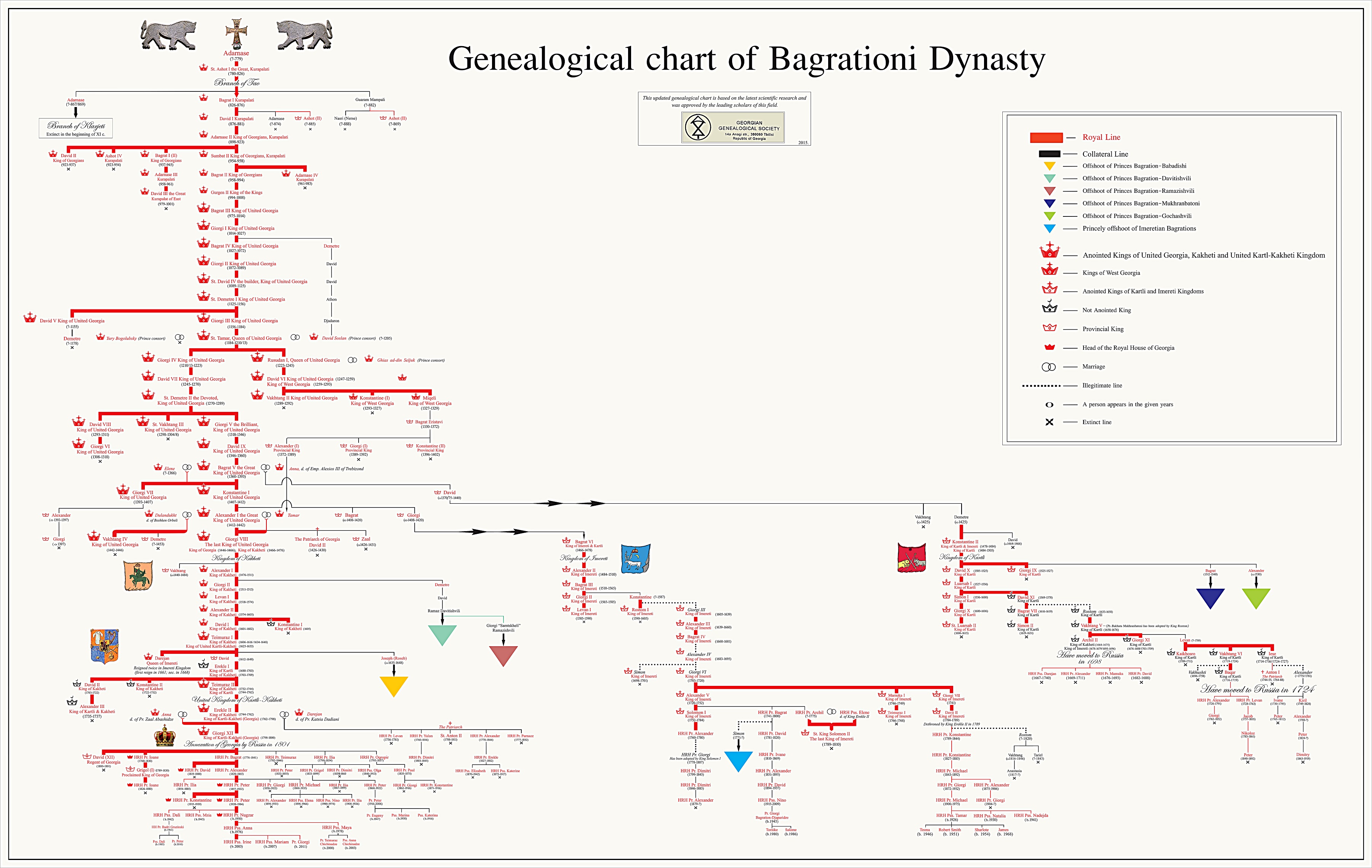

 The Patriarch concurred and thought that there would be plenty of time before Easter for both parties to prepare the necessary documentation to enact the contract. As part of this agreement, His Royal Highness Prince Nugzar, in good faith, transferred all important historical and genealogical documents to the Patriarch.
The Patriarch concurred and thought that there would be plenty of time before Easter for both parties to prepare the necessary documentation to enact the contract. As part of this agreement, His Royal Highness Prince Nugzar, in good faith, transferred all important historical and genealogical documents to the Patriarch.

 Information obtained by the royal Chancellery concludes that Prince David's behavior may be related to David's grandfather's sister, Leonida Bagration-Mukhranski. Her marriage to Vladimir Kirilovich Romanov produced Maria Vladimirovna, who is a claimant to the Russian Imperial Throne. These persons try to circumvent the morganatic requirements of Russia by portraying the Mukhranski branch as belonging to the Kartli royals. The information on which these claims are made is flawed and is recognized as such by the majority of the Romanov family.
Information obtained by the royal Chancellery concludes that Prince David's behavior may be related to David's grandfather's sister, Leonida Bagration-Mukhranski. Her marriage to Vladimir Kirilovich Romanov produced Maria Vladimirovna, who is a claimant to the Russian Imperial Throne. These persons try to circumvent the morganatic requirements of Russia by portraying the Mukhranski branch as belonging to the Kartli royals. The information on which these claims are made is flawed and is recognized as such by the majority of the Romanov family. There are also widely publicized myths that in the early 1990s, the Georgian government and His Holiness the Patriarch recognized George (Jorge) Bagration-Mukhranski as the heir to the Georgian throne. No such evidence of this exists at all, especially in written form. However, there is an interesting written letter by Maria Bagration, Prince David's aunt, which indicates that her father excluded Giorgi (David's father) and his descendants from their rights. If true, then David, and his siblings, would not even be princes of the nobility of Georgia, let alone royal claimants.
There are also widely publicized myths that in the early 1990s, the Georgian government and His Holiness the Patriarch recognized George (Jorge) Bagration-Mukhranski as the heir to the Georgian throne. No such evidence of this exists at all, especially in written form. However, there is an interesting written letter by Maria Bagration, Prince David's aunt, which indicates that her father excluded Giorgi (David's father) and his descendants from their rights. If true, then David, and his siblings, would not even be princes of the nobility of Georgia, let alone royal claimants. Another historical example is King of Kings (really Queen of Queens) Tamar of Georgia. She married Prince David Soslan, who was a member of the Bagrationi Dynasty that ruled Alania (modern-day Ossetia). While both King (Queen) Tamar and the Prince consort had identical surnames, the son born from this marriage in historic sources is known as King Giorgi IV Bagrationi. King Giorgi IV reigned from 1210 - 1223. Historical sources demonstrate that King Giorgi IV in accordance with succession rules inherited his royal rights through his mother, not his father.
Another historical example is King of Kings (really Queen of Queens) Tamar of Georgia. She married Prince David Soslan, who was a member of the Bagrationi Dynasty that ruled Alania (modern-day Ossetia). While both King (Queen) Tamar and the Prince consort had identical surnames, the son born from this marriage in historic sources is known as King Giorgi IV Bagrationi. King Giorgi IV reigned from 1210 - 1223. Historical sources demonstrate that King Giorgi IV in accordance with succession rules inherited his royal rights through his mother, not his father.